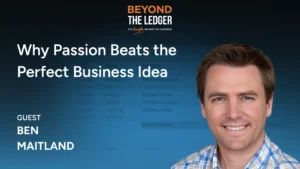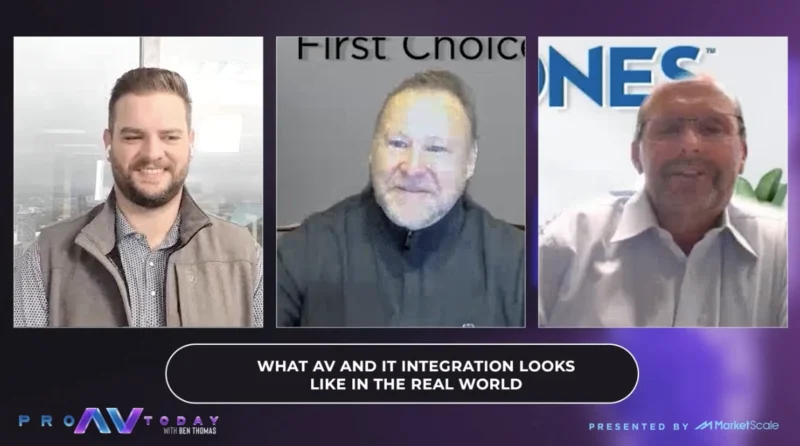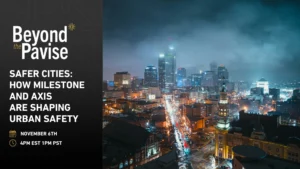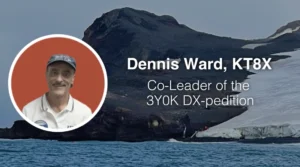The Next Generation of Broadcast Cameras
The world of broadcast quality cameras has expanded beyond the traditional barriers of terrestrial TV. Houses of worship, educational institutions, sports leagues and more have taken advantage of more accessible pricing as well as a more manageable form factor.
One of the pioneers of the modern POV camera, Tod Musgrave of Marshall Electronics, joined Pro AV Today host Ben Thomas to break down the past, present and future of this new landscape. Check out the discussion below:
*Transcript is auto-generated*
BT: Hey, everybody, welcome back to Pro AV Today. Selfishly, this is going to be one of my favorite episodes at heart. I am a camera guy. I love the optics. I love the resolution increases. But what’s been interesting about the last 5 to 10 years is that you’ve seen cameras that previously weren’t accessible even in broadcast settings, spread out to markets like house of worship and localized sports, things like that. And one of the guys responsible for really leading that charge is my next guest. I’ve got Tod Musgrave on from Marshall. Tod, Thanks so much for coming on today.
TM: Thanks for having me. It’s quite flattering. Thank you.
BT: Well, Tod, it’s flattering, but it’s true. You guys over at Marshall are known really at scale for your great PTZ and POV cameras. And I know that whether or not you want to take a lot of credit for it, you have been the driver for a lot of that success. Right whether that’s in broadcast applications specifically. But even we could talk a little bit later about some of those UCC applications. But from a broadcast standpoint specifically now we’re talking about cameras that you guys are creating that are literally a 101/100 of the size of what we would think of when we’re looking at those giant box cameras. Talk to me a little bit about where we are in the life cycle of really those POV and PTZ cameras for use in broadcast settings.
TM: So we started off about a decade ago. And really we’ve always been in broadcast, right? Marshall’s been around for 40 years in broadcast, maybe most of that time in monitors, heavy analytic monitors with waveform vector scopes, that kind of thing. And then so my, my job when I came to the, to the company was to create another segment, which was POV cameras. Right? something that we first saw were very kind of security ish, if you will. And it was my job to add all those broadcast features, right? The remote adjustability, the adjustment of virus or shading and other remote adjustable features in our cameras, also with interchangeable lenses. So we created some flexibility, if you will, for the different POV shots. And then today we have stuff like our head that makes our little POV camera movable, right? And adjustable, you know, when you want to adjust the right or the left or just slightly. So we’ve come a long way from our initial camera. We’ve incorporated more broadcast centric feature sets. We’ve refined and refined signals because the first thing that a broadcaster will do when you give them a camera is they’ll plug it into a signal analyzer, right? They won’t even look at the broadcast. They won’t look at the quality of the color necessarily before they look at the signal and the structure of the signal and how much noise is on the signal. So so we’ve refined over for many number of years. We’ve gotten better every generation. And I can’t think of any sport on the planet that’s not using our POV cameras to some degree for an extra shot, whether it be a backboard camera or in the pits of a race event or even like warming up pitchers in Major League Baseball or on the backstop. So it all it gives me chills because really, I love hearing about the applications. I love hearing how our broadcast users are using them, most importantly, what they want to see in the next generation.
BT: Well, Tod, it’s been really cool to see the work that you guys have done, because really, when you talk about those smaller form factor cameras, really, they kind of made their way into the public eye largely through what, like the GoPros and things like that. And then you see the demand, whether it’s through houses of worship or smaller broadcasters, you see the demand for that smaller form factor in it being broadcast cameras, whether it’s SDI outputs. You talked about things like iris control. You know, you guys have kind of been forced to innovate a lot of times before, really the end user even knew that they wanted it. And that reminds me a lot of if you remember the original XFL back in the days where they introduced the sky Cam and really introduced the rebirth of the steadicam, you guys reminded me a lot of that from a technology. And in an anticipation standpoint, you know, how do you design for something that the end user of the broadcast or the engineer doesn’t even know that they need yet?
TM: Well, we work closely with broadcast engineers working those events you talk about. Right so whether it be in professional basketball, football and even now with lacrosse, you know, with the big broadcast events are doing in lacrosse. Really, it’s a matter to me first to start with the sensor to make sure the video quality is up to standards. Now we have use, like I said, say, in Major League Baseball. Right there’ll be a small camera while they’re warming up a pitcher or sometimes just a coach camera, right. Where they’re analyzing the pitcher on the mound exclusively and they’re watching for fatigue. But I always like them getting on air. Right so it’s the stuff they bury in the dirt in front of home plate for the all-Star game or built into the cap of like the shortstop and getting that ball coming to him and him making the play. That’s exciting stuff, man. It was a kicker, too. The idea for me is always I want it to be broadcast quality. We select the right sensors for that and we continually refine and adjust. And we and really, we work with a lot of engineers that are at these events that want some certain thing changed or made easier to remove the headache. And that’s what’s paramount for me is to stay close to those broadcast engineers and keep refining and keep improving.
BT: Well, what’s really cool about really specifically the Marshall cameras is you see them in things like the all-Star game and obviously the biggest places in the world. But, you know, some of the things that you guys allow really has democratized broadcast production, not only from an acquisition standpoint, but from, you know, maybe a smaller budget standpoint, too. Now, you talk about educational institutions being able to broadcast their games or houses of worship. Now being able to stream at scale, not only with the great POV cameras, but obviously some of the PTZ and robotic options as well. Talk to me a little bit about some of those maybe non-traditional non-sports markets that you guys are seeing growth in.
TM: Well, let me start with the sports for a second, because it’s a very interesting, interesting point you bring up normally or historically. It’s always been football, basketball and a handful of sports. Now, as you said, they can broadcast more. They can do linear and digital broadcasting. And they’re capturing more of their sports and now they’re showing gymnastics. I mean, how good has girls softball gotten, right? I mean, the production value is insane. So so a lot of that comes from what the SEC networks and the ACC networks and Pac 12 networks in coordination with companies like ESPN and Fox Sports. But that is getting more content, being able to show more events, being able to do more stories with additional points of view. Right so from an entry level standpoint, to add a lot of low cost, miniature POV cameras is great. Again with sports is from the very beginning with sports and different shots, but also largely in live music, right? Live events like a house of worship, church production, you know, it’s very inexpensive to add a three, $400 or $500 POV camera at first because maybe they were using an old style camera and standard definition and trying to make it work. So it’s a very we offer anywhere from entry level. We like to call to added and higher priced cameras depending on the complexity of what you want to do. But I mean, how exciting is that to be able to cover more events, to cover more? I mean, everybody wants to be a podcast star, right, from their base. Right so, so so we have cameras that have not only have broadcast standard SDI, but hdmi, also IP. We’ve added NDI capability. Now we’re incorporating NDI three, which is even more low latency. And to be able to pipe in a shot from even remotely right for contributor even news news outlets right newscast we have a lot of especially during COVID. But now it’s become standard, right? It’s a lot cheaper to send a camera to send a camera operator and a camera out. Right so you see a lot more production and sports, but even newscasts and news contribution, weather casting, house of worship. We you know, I love to talk about the stuff we do in space because we have more cameras in space, I think, than anyone. And I can’t elaborate too much in that. But a lot of the shots you see of rockets launching and getting together in the International Space Station of the James Webb telescope that was just released into space. I mean, what would you call that? Would you call that broadcast pro tv? It doesn’t matter to me, really, because I want to make my stuff as good video is possible and is easy to integrate and we’re rewarded with some very unique applications. And we love it. We continue to try to get better. Again, looking ahead at adding this IP and NDI and SRT and we’re adding xixi to some of our IP cameras. So so we want to stay ahead of it. We want to make it easy. We can we collaborate with a lot of companies laterally speaking to make sure it’s compatible and easy to use. That’s really what we’d like to focus on.
BT: Well, you talked a little bit about the lines blurring between what you would call the av, the broad. Yes even the it integrator community is one of the markets that it seems like everybody’s trying to scoop up at this point is the UCC market, but you guys have an interesting place in that market because it really, if you think about it, at the end of the day, video conferencing collaboration is a form of broadcast, right? And people now have made the determination to invest in their setups and their gear and their microphones, and that includes their cameras. To talk a little bit about some of the things that you guys are seeing in the UCC space.
TM: So when you talk about UCC initially, what comes to mind is collaboration over video, right? That was really exploded during COVID. Everybody had to work remotely, right? And Thank god, before COVID started, we had some USB options, even in miniature size, we had some USB PTZ and other options. Now, I mean, it’s not just over a video call or video chat, it’s now it’s podcasting, it’s creating content very easily over OBS or mics. I mean, these things are very affordable these days. They’re looking for more than just a, you know, a PC camera or a camera built into their computer. They want better quality. And we were in a unique position to be able to do that. We continue to collaborate with companies like Zoom certification for Zoom rooms. We have barco click Share certification. We work with vMX 2 make sure it’s easily ingestible and controllable through their platform. We work with free or OBS project to incorporate docs and plug-ins where you can control the camera if it is a PTZ or even a common Zoom block. We’re also coming out with a EP z camera in for 20 e, which is a 4K 60 sensor, large sensor and being able to manipulate within that 4K sensor with HD video and keep that camera shot still. And you oversaw codecs like we’re on now, right for video conference or streaming but I think it’s a really interesting time in that UCC is now I mean it’s kind of an old term if you will, because, because really, I mean any, any one of our cameras can be plugged into USB, can be plugged into IP. Now with NDI and other things like SRT, very low latency, very lossless video over IP, you know, the world is opening up and it’s so exciting to see people with maybe a lower budgets being able to produce some high quality programming like yourself.
BT: Oh yes, just like me. I it would be a stretch to call this high quality programming. I appreciate that.
TM: But you know, you’re not using the camera that’s built in your computer, right?
BT: That’s true. You know what? That is true. I’ll pat myself on the back. I’ll allow I’ll allow it. But I’m an AV guy. I can’t you know, I can’t use that built in stuff. You know what’s exciting, though, is, is as you see, broadcast grade cameras kind of dripping into newer markets. You talked a little bit about UCC or the dated term UCC, if we will, but there’s also an interesting new market. And this it’s very emerging and we’ll talk about it kind of on a higher level because nobody really knows quite where this market is going to go. And obviously, I’m talking about AI broadcasting and AI technologies over cameras, and it’s almost hard to even have a discussion about because you talk about AI production, and it can mean a lot of different things for some it might mean, hey, I’ve got the 4K sensor like you talked about and I’ve got the 1080p tracking happening, right? Technically that’s AI production, but, you know, extrapolated all the way up to, hey, there’s a machine making decisions on when we’re cutting or when we need to Zoom and when we don’t need to Zoom. And it’s an interesting topic. So on a high level, Tod, you know, talk to me about what you guys are just seeing demand for, right? Are people even asking for AI productions right now?
TM: So we get asked a lot for track and follow. As you talked about, we have a 4K sensor where you can move that H&E image within it, but we also have a track and follow camera that’s coming out that has the capability, recognizes faces, learns and recognizes faces. It learns to how to move with the presenter. It it uses AI to anticipate movement so it’s more natural, you know, so you don’t want a self control AI PTZ camera moving quickly or making drastic corrections. So there’s some AI and learn capability with this 620 camera we have coming out, but we are getting asked that more and more. And I think it has to do with maybe less personnel on site, or maybe fewer people at a house of worship, for instance, and the camera doing. Some of the work for people may be understaffed organizations, but we are getting that ask that more and more. We’ve added Ar and VR to more concisely control our cameras in Ar environments. It’s not exactly AI, but it’s similar in that it’s ingesting and and ingesting video content into workflows that adds graphics. Right and that maybe AI graphics or meshing graphics or overlays into video content in a more natural way. And that a lot of that is done through eye of the camera and the processing and certainly the workflow codecs that they’re being used.
BT: Well, Tod, the natural next question is this and I’ll wrap with this. You know, obviously, it’s pretty easy to say that our resolution is going to continue to increase our form factors are going to continue to increase efficiency. Productivity is going to continue to increase with cameras. But what are some of the things in the next five, 10 years that maybe end users in broadcasters aren’t expecting from? Maybe guys and maybe it’s even the camera industry as a whole.
TM: Well, lately, and certainly a lot of the work that’s being done now is to make IP more are easier to use. Right and that has to do I mean, we have 4K cameras, right? We have real true 4K. We have HD, we have HD. But really, it’s not chasing resolution more than it is making it usable and congested all over network. Right I mean to and sometimes challenging network infrastructure. So with the incorporation of MDI 3×3, you’re seeing lower latency. So if this lower latency IP approaches, say latency of SDI, it becomes very interesting in broadcast and we have a high bandwidth version coming out that takes slightly higher bandwidth that is near lossless or near SD latency. But also when you pack and unpack the video information that it’s lossless essentially. So you see a lot of IP or India or xdr-tb and Inc bandwidth being expanded and faster and better. So you can remotely ingest a camera and in a remote location or ingest videos or graphics and other things remotely are in the cloud. So it’s not just higher resolution cameras. It’s cameras that are more capable of IP network, which is not necessarily improving resolution of a sensor physically. But we do a couple of things. We first are always looking at New sensors and capabilities. We’re looking at ACK stuff, but how many people can consume and use ARRC right now? A lot of people even using 4K at this point. But to be able to use HD over challenging networks remotely with less people, REMI production is very interesting and we work with a lot of companies to make sure that we’re coding. We’re making it Mary and mesh well in the soft codecs that are being used. So not only higher resolution but also incorporating some of the things that we talked about. And we’ll continue to follow that and to see how we can use that in our cameras to make them smarter.
BT: Tod, I’ll give you the last word here. Shameless plug. I know you guys are out on the road this summer. Well, I guess we’re outside of summer now. We can say that we’re basically in fall and throughout the next year. Where are you guys going to be and drop a couple of booth numbers if you got them off top.
TM: Yeah so so we’re usually at the Nab is we’ll be at the Nab east, we’re going to be at IVC here. And coming up real quick, so as all these trade shows open up and we’ll be going to them and showing our latest and greatest next one will be IBC in several weeks. So we’ll have a booth there. You put me on the spot. That’s my job. I’ve got to catch you on something you’re not prepared for. Oh, it’s brutal. So? so we’re in the Hall. Sit up. I want to. Here we go.
BT: They’re going to be at IBC. If you can’t find them, that’s your fault.
TM: Here we go. I got it. Booth number 11 and c, 23. So Hall 1123, which is a little bit different, where we were in the past. But if you’re looking for us, we’ll be right next to the outermost booth. Right so but if you’re looking for a camera, for your production or live event, whether it be house of worship, broadcast sports, cast, newscast, all of our cameras can be found on a website. Marshall dash, USA.
BT: Look, Tod, we appreciate you coming on the show today. Ladies and gentlemen, Todd Musgrave from Marshall electronics, the father I’m going to say this, the father of the modern POV camera, and I’m going to give you that.
TM: I love it. Thanks, Ben, for having us. I appreciate it.
BT: Absolutely and Thank you so much for joining. Tune in next week.








